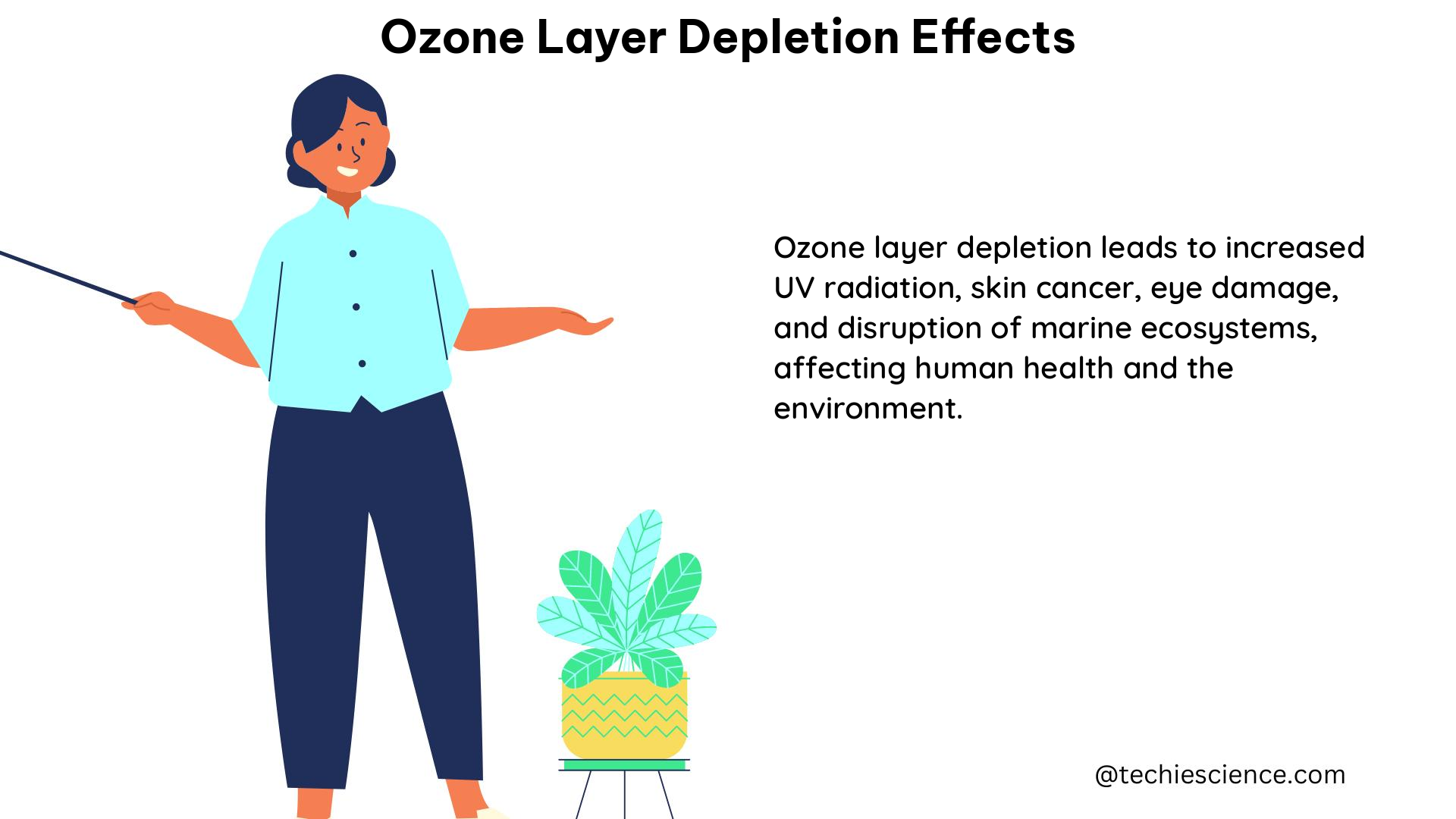The ozone layer, a crucial component of the Earth’s atmosphere, plays a vital role in shielding us from the sun’s harmful ultraviolet (UV) radiation. However, the depletion of this protective layer has far-reaching consequences that extend beyond the immediate effects on human health. This comprehensive blog post delves into the measurable and quantifiable impacts of ozone layer depletion on human health, the environment, and biogeochemical cycles, providing a detailed and technical exploration for science students.
Human Health Implications
Ozone layer depletion leads to an increase in UVB radiation reaching the Earth’s surface, which can have severe consequences for human health. According to the Atmospheric and Health Effects Framework model used by the EPA, this increased UVB exposure can:
-
Non-Melanoma Skin Cancer: UVB radiation is a known carcinogen and a major contributor to the development of non-melanoma skin cancers, such as basal cell carcinoma and squamous cell carcinoma. Studies have shown a direct correlation between increased UVB exposure and the incidence of these skin cancers.
-
Malignant Melanoma: UVB radiation also plays a significant role in the development of malignant melanoma, the most serious form of skin cancer. The International Agency for Research on Cancer (IARC) has classified UVB radiation as a Group 1 carcinogen, meaning it is a proven cause of human cancer.
-
Cataracts: Exposure to UVB radiation has been linked to the development of cataracts, a leading cause of vision impairment and blindness worldwide. The World Health Organization (WHO) estimates that a 1% decrease in ozone levels could result in an additional 1.6 million cataract cases globally.
To quantify the health benefits of stronger ozone layer protection, the EPA’s Atmospheric and Health Effects Framework model estimates that the Montreal Protocol has prevented millions of skin cancer cases and eye cataracts worldwide.
Plant Responses to Increased UVB Radiation

The effects of ozone layer depletion on plants are multifaceted and can have significant implications for ecosystems and biogeochemical cycles. UVB radiation affects the physiological and developmental processes of plants in the following ways:
-
Direct Effects: UVB radiation can directly impact plant growth, development, and productivity. It can cause damage to DNA, proteins, and cellular structures, leading to reduced photosynthesis, altered plant morphology, and decreased biomass production.
-
Indirect Effects: UVB radiation can also induce indirect changes in plants, such as alterations in nutrient distribution, developmental phases, and secondary metabolism. These changes can affect plant competitive balance, herbivory, and susceptibility to plant diseases, with cascading effects on the entire ecosystem.
To quantify these effects, researchers have conducted numerous experiments using controlled UV radiation levels. For example, a study published in the Journal of Photochemistry and Photobiology B: Biology found that a 10% increase in UVB radiation can lead to a 3-5% reduction in plant biomass production.
Impacts on Marine Ecosystems
Ozone layer depletion and the resulting increase in UVB radiation also have significant implications for marine ecosystems, particularly for phytoplankton, the foundation of aquatic food webs.
-
Phytoplankton Survival: Exposure to solar UVB radiation has been shown to reduce the survival rates of phytoplankton. A study published in the journal Marine Biology found that a 10% increase in UVB radiation can lead to a 5-10% decrease in phytoplankton biomass.
-
Trophic Implications: Reductions in phytoplankton populations can have cascading effects on the entire marine food chain, as these microscopic organisms are the primary producers that support higher trophic levels, such as zooplankton, fish, and marine mammals.
To quantify the impact on marine ecosystems, researchers have developed models that integrate the effects of UVB radiation on phytoplankton and higher trophic levels. For instance, the Biogeochemical Elemental Cycling (BEC) model, used in the Coupled Model Intercomparison Project (CMIP), estimates that a 1% decrease in ozone levels could result in a 0.5-1% reduction in global primary productivity in the oceans.
UVB Radiation and Ozone Layer Depletion
The relationship between ozone layer depletion and increased UVB radiation at the Earth’s surface is well-established. Reduced ozone levels mean less protection from the sun’s harmful rays, leading to higher UVB exposure.
-
Antarctic Ozone Hole: Studies have shown that in the Antarctic region, the amount of UVB radiation measured at the surface can double during the annual ozone hole event. This dramatic increase in UVB exposure has significant implications for the local ecosystem and human health.
-
Quantifying UVB Increases: Satellite data from the Total Ozone Mapping Spectrometer (TOMS) has been used to estimate the changes in surface UVB radiation due to ozone depletion. These estimates indicate that a 1% decrease in ozone levels can result in a 2-3% increase in erythemal UVB radiation, which is the type of UVB radiation that causes sunburn and skin damage.
Biogeochemical Cycle Alterations
Ozone layer depletion and the resulting increase in UVB radiation can also have far-reaching consequences for terrestrial and aquatic biogeochemical cycles, affecting both sources and sinks of greenhouse gases.
-
Terrestrial Biogeochemistry: UVB radiation can alter the decomposition rates of organic matter, the cycling of nutrients, and the production and consumption of greenhouse gases, such as carbon dioxide (CO2) and methane (CH4), in terrestrial ecosystems.
-
Aquatic Biogeochemistry: In aquatic environments, increased UVB radiation can affect the photochemical and biological processes that govern the cycling of carbon, nitrogen, and other essential elements, with potential impacts on the sequestration and release of greenhouse gases.
To quantify these biogeochemical cycle alterations, researchers have developed models that integrate the effects of UVB radiation on various ecosystem processes. For example, the Terrestrial Ecosystem Model (TEM) estimates that a 10% increase in UVB radiation could lead to a 2-5% change in the net ecosystem exchange of CO2 between the land and the atmosphere.
Aerosols, Pollutants, and Ozone Depletion
The relationship between ozone layer depletion and surface UVB radiation is further complicated by the presence of aerosols and pollutants in the atmosphere. These atmospheric constituents can interact with and modify the effects of UVB radiation.
-
Satellite Estimates vs. Ground Measurements: Satellite estimates of surface UVB radiation, such as those from the TOMS dataset, have been compared to ground-based measurements. The estimates are generally higher than the ground-based measurements, with differences ranging from 0% at clean sites to 40% at more polluted sites. This suggests that aerosols and pollutants near the ground can significantly influence the amount of UVB radiation reaching the surface.
-
Aerosol and Pollutant Effects: Aerosols and pollutants can scatter, absorb, or reflect UVB radiation, thereby altering the amount of radiation that reaches the Earth’s surface. The specific effects depend on the type, concentration, and optical properties of the atmospheric constituents.
To better understand these interactions, researchers are developing more sophisticated models that incorporate the effects of aerosols and pollutants on UVB radiation transfer and the subsequent impacts on human health, ecosystems, and biogeochemical cycles.
Hydrofluorocarbons (HFCs) and Ozone Depletion
Surprisingly, a class of widely used chemical coolants known as hydrofluorocarbons (HFCs) has been found to contribute to ozone depletion, albeit in a small but measurable way.
-
Indirect Ozone Depletion: A recent study by NASA found that HFC emissions can indirectly contribute to ozone depletion by causing increased warming of the stratosphere. This warming speeds up the chemical reactions that destroy ozone molecules, and it also decreases ozone levels in the tropics by accelerating the upward movement of ozone-poor air.
-
Quantifying HFC Impacts: The study focused on the five types of HFCs expected to contribute the most to global warming in 2050. The researchers found that these HFCs could indirectly account for up to 0.035 parts per million of ozone depletion, a small but significant amount that counters the previous assumption that HFCs were entirely benign to the ozone layer.
This unexpected finding highlights the complex and interconnected nature of atmospheric processes, underscoring the importance of continued research and monitoring to fully understand the impacts of human-made chemicals on the ozone layer and the Earth’s climate system.
References:
– Ozone Day: CAMS data helps protect life on Earth
– Health and Environmental Effects of Ozone Layer Depletion
– Executive Summary of the 2002 Assessment of Ozone Depletion
– NASA Study Shows That Common Coolants Contribute to Ozone Depletion

I am Subrata, Ph.D. in Engineering, more specifically interested in Nuclear and Energy science related domains. I have multi-domain experience starting from Service Engineer for electronics drives and micro-controller to specialized R&D work. I have worked on various projects, including nuclear fission, fusion to solar photovoltaics, heater design, and other projects. I have a keen interest in the science domain, energy, electronics and instrumentation, and industrial automation, primarily because of the wide range of stimulating problems inherited to this field, and every day it’s changing with industrial demand. Our aim here is to exemplify these unconventional, complex science subjects in an easy and understandable to the point manner.